Analysis of Spatiotemporal Dynamics and Driving Mechanisms of Cultural Heritage Distribution Along the Jiangnan Canal, China
Abstract
1. Introduction
- a.
- b.
- c.
- Multi-tool spatial framework. We combine kernel density estimation, standard deviation ellipse, multi-ring buffer analysis, and the Geodetector model [28] to (i) map clustering and directional trends, (ii) trace temporal shifts in centers of gravity, and (iii) quantify each driver’s explanatory power (q-values) and interaction effects under complex human–environment dynamics.
2. Materials and Methods
2.1. Study Area
2.2. Data Sources
2.3. Research Methods
2.3.1. Multiple Ring Buffer
2.3.2. Nearest Neighbor Index
2.3.3. Kernel Density Estimation
2.3.4. Standard Deviation Ellipse Model
2.3.5. Geodetector Model
3. Results and Analysis
3.1. Spatiotemporal Distribution of Jiangnan Canal Cultural Heritage
3.1.1. Spatiotemporal Distribution of TCH
3.1.2. Spatiotemporal Distribution of ICH
3.2. Analysis Results of Multiple Ring Buffer
3.2.1. Results of TCH Analyzed by MRB
3.2.2. Results of ICH Analyzed by MRB
3.3. Analysis Results of NNI
3.3.1. Results of NNI Analysis of TCH over Time
3.3.2. Results of NNI Analysis of ICH over Time
3.4. Analysis Results of Kernel Density Estimation
3.4.1. Results of KDE Analysis of TCH over Time
3.4.2. Results of KDE Analysis of ICH over Time
3.5. Analysis Results of Standard Deviation Ellipse
3.5.1. Results of TCH Analyzed by SDE
3.5.2. Results of ICH Analyzed by SDE
3.6. Analysis of Results from the Geodetector Model
4. Discussion
4.1. Spatiotemporal Dynamics and Patterns
4.2. Human-Water Interactions as Driving Mechanisms of Cultural Heritage
4.3. Limitations and Future Research Directions
5. Conclusions
- (1)
- The MRB Analysis revealed that 77.2% of TCH and 49.8% of ICH were concentrated within 0–10 km of the canal. TCH quantities exhibited a distance-decay trend (258 within 0–10 km vs. 14 beyond 30 km), while ICH displayed localized increases in distal zones (>30 km; e.g., 44 Ming–Qing cases, Ming–Qing: 1368–1912 AD), implying factor heterogeneity. Nevertheless, the canal’s gravitational effect on cultural heritage remained dominant.
- (2)
- The NNI analysis revealed that both TCH and ICH along the Jiangnan Canal exhibited statistically significant clustered distribution patterns across all historical periods (R < 1, p < 0.01). For TCH, the Sui and Tang Dynasties (Sui–Tang: 581–907 AD) showed a notable expansion in distribution range, with an average observed distance of 10,333 m and an expected distance of 13,977 m. For ICH, the Ming and Qing Dynasties exhibited the highest clustering intensity (z = −12.4390, p = 0.000), indicating non-random spatial aggregation.
- (3)
- As revealed by KDE Analysis, the TCH in cities along the Jiangnan Canal shows an uneven distribution with a “one axis and many cores” pattern in different periods, all centered around the Jiangnan Canal. These high-density cores experienced spatiotemporal shifts but remained spatially coupled with the canal. ICH exhibited multifaceted distribution complexity. It gradually evolved from a scattered state to an aggregated pattern along the canal. In most periods, high-density ICH clusters were canal-proximal, confirming the canal’s structural centrality in ICH formation.
- (4)
- The SDE analysis revealed that the center of gravity of TCH shifted across historical periods, yet consistently clustered around Taihu Lake. The standard ellipses of different periods were highly consistent with the orientation of the Jiangnan Canal, with a relatively long major axis, short minor axis, and large flattening rate, reflecting the concentrated distribution of TCH along the canal. The center of gravity of ICH was mainly located on the south side of Taihu Lake, and its distribution direction in each period extended along the Jiangnan Canal. The difference in the major and minor axes of the ellipses in different periods indicated varying degrees of directional distribution and dispersion of ICH.
- (5)
- As analyzed by the Geodetector, for both TCH and ICH, nighttime light intensity exerted the strongest explanatory power for their spatial distribution, followed by factors such as the distance-to-Jiangnan-Canal, population density, and GDP. Terrain elevation exhibited the lowest explanatory power. This demonstrates that human activities are the most crucial driving factors in the spatial distribution of cultural heritage. Population density and GDP reflect the intensity of human activities from a socioeconomic perspective, and the relatively high q-statistics value of the distance-to-Jiangnan-Canal factor further validates the importance of the canal. In the study area, due to the extensive plain terrain, the elevation factor has the lowest explanatory power.
Author Contributions
Funding
Institutional Review Board Statement
Informed Consent Statement
Data Availability Statement
Acknowledgments
Conflicts of Interest
Abbreviations
| TCH | Tangible Cultural Heritage |
| ICH | Intangible Cultural Heritage |
| MRB | Multiple Ring Buffer |
| GIS | Geographic Information System |
| NNI | Nearest Neighbor Index |
| KDE | Kernel Density Estimation |
| SDE | Standard Deviation Ellipse |
| GDP | Gross Domestic Product |
References
- Chen, M.; Wang, J.; Sun, J.; Ye, F.; Zhang, H. Spatio-Temporal Distribution Characteristics of Intangible Cultural Heritage and Tourism Response in the Beijing–Hangzhou Grand Canal Basin in China. Sustainability 2023, 15, 10348. [Google Scholar] [CrossRef]
- Bai, Q.; Gao, M.; Lyu, H.; Zhang, L.; Zhang, J. Spatial Distribution Characteristics and Influencing Factors of Tangible Cultural Heritage in Henan Province, China: A Watershed Perspective. Sustainability 2024, 16, 8979. [Google Scholar] [CrossRef]
- UNESCO. The Grand Canal. 2014. Available online: https://whc.unesco.org/en/list/1443%20(2014) (accessed on 10 December 2024).
- Yan, H.M. The making of the Grand Canal in China: Beyond knowledge and power. Int. J. Herit. Stud. 2021, 27, 584–600. [Google Scholar] [CrossRef]
- UNESCO. Convention Concerning: The Protection of the World Cultural and Natural Heritage. 1972. Available online: https://whc.unesco.org/en/conventiontext/%20(1972) (accessed on 10 December 2024).
- UNESCO. What Is Intangible Cultural Heritage. 2004. Available online: https://ich.unesco.org/en/what-is-intangible-heritage-00003 (accessed on 10 December 2024).
- Bastian, O.; Walz, U.; Decker, A. Historical landscape elements: Part of our cultural heritage—A methodological study from Saxony. In The Carpathians: Integrating Nature and Society Towards Sustainability; Springer: Berlin/Heidelberg, Germany, 2013; pp. 441–459. [Google Scholar]
- Huang, Y.; Yang, S. Spatio-temporal evolution and distribution of cultural heritage sites along the Suzhou canal of China. Herit. Sci. 2023, 11, 188. [Google Scholar] [CrossRef]
- Zhang, J.; Jiang, L.; Wang, X.; Chen, Z.; Xu, S. A Study on the Spatiotemporal Aggregation and Corridor Distribution Characteristics of Cultural Heritage: The Case of Fuzhou, China. Buildings 2024, 14, 121. [Google Scholar] [CrossRef]
- Fang, W.; Zhuoqi, L.; Ying, D.; Leye, W. Cultural Heritage Conservation from the Perspective of River Basin. Herit. Archit. 2024, 12, 44. [Google Scholar]
- Zhang, T.X.; Yang, Y.L.; Fan, X.; Ou, S.Y. Corridors Construction and Development Strategies for Intangible Cultural Heritage: A Study about the Yangtze River Economic Belt. Sustainability 2023, 15, 13449. [Google Scholar] [CrossRef]
- Cheng, Q.; Ling, S. Geographical Distribution and Affecting Factors of the Intangible Cultural Heritage in China. Sci. Geogr. Sin. 2013, 33, 1166–1172. [Google Scholar]
- Zhang, S.; Zhang, X.; Liu, J. Spatial distribution and pedigree age of intangible cultural heritage along the Grand Canal of China. Herit. Sci. 2024, 12, 246. [Google Scholar] [CrossRef]
- Yang, J.; Wang, L.; Wei, S. Spatial Variation and Its Local Influencing Factors of Intangible Cultural Heritage Development along the Grand Canal in China. Int. J. Environ. Res. Public Health 2022, 20, 662. [Google Scholar] [CrossRef]
- Li, L. Cultural communication and diversity along the Grand Canal of China: A case study of folk songs in intangible cultural heritage. Herit. Sci. 2023, 11, 66. [Google Scholar] [CrossRef]
- Perez-Alvaro, E. Climate change and underwater cultural heritage: Impacts and challenges. J. Cult. Herit. 2016, 21, 842–848. [Google Scholar] [CrossRef]
- Wojcieszak, M.; Van den Brande, T.; Ligovich, G.; Boudin, M. Pretreatment Protocols Performed at the Royal Institute for Cultural Heritage (Rich) Prior to AMS 14C Measurements. Radiocarbon 2020, 62, E14–E24. [Google Scholar] [CrossRef]
- Morel, H.; Ammerveld, J.O. From Climate Crisis to Climate Action: Exploring the Entanglement of Changing Heritage in the Anthropocene. Hist. Environ.-Policy Pract. 2021, 12, 271–291. [Google Scholar] [CrossRef]
- Ciski, M.; Rzasa, K.; Ogryzek, M. Use of GIS Tools in Sustainable Heritage Management—The Importance of Data Generalization in Spatial Modeling. Sustainability 2019, 11, 5616. [Google Scholar] [CrossRef]
- Agapiou, A.; Lysandrou, V.; Alexakis, D.D.; Themistocleous, K.; Cuca, B.; Argyriou, A.; Sarris, A.; Hadjimitsis, D.G. Cultural heritage management and monitoring using remote sensing data and GIS: The case study of Paphos area, Cyprus. Comput. Environ. Urban Syst. 2015, 54, 230–239. [Google Scholar] [CrossRef]
- Fu, J.; Mao, H. Study on the spatiotemporal distribution patterns and influencing factors of cultural heritage: A case study of Fujian Province. Herit. Sci. 2024, 12, 324. [Google Scholar] [CrossRef]
- Anderson, B. Cultural geography 1: Intensities and forms of power. Prog. Hum. Geogr. 2017, 41, 501–511. [Google Scholar] [CrossRef]
- Timothy, D.J. Contemporary Cultural Heritage and Tourism: Development Issues and Emerging Trends. Public Archaeol. 2014, 13, 30–47. [Google Scholar] [CrossRef]
- Lin, F.Y.; Zhang, X.; Ma, Z.Y.; Zhang, Y.F. Spatial Structure and Corridor Construction of Intangible Cultural Heritage: A Case Study of the Ming Great Wall. Land 2022, 11, 1478. [Google Scholar] [CrossRef]
- Yu, K.; Xi, X. The Definition of the Grand Canal Heritage Corridor Based on the Genesis Perspectives. Prog. Geogr. 2010, 29, 975–986. [Google Scholar]
- Zhang, S.Y.; Liu, J.M.; Pei, T.; Chan, C.S.; Wang, M.D.; Meng, B. Tourism value assessment of linear cultural heritage: The case of the Beijing-Hangzhou Grand Canal in China. Curr. Issues Tour. 2023, 26, 47–69. [Google Scholar] [CrossRef]
- Shi, G.; Feng, Z.; Zhang, J.; Xu, J.; Chen, Y.; Liu, J.; Wang, Y. An Analysis of the Spatiotemporal Distribution and Influencing Factors of National Intangible Cultural Heritage Along the Grand Canal of China. Sustainability 2024, 16, 9138. [Google Scholar] [CrossRef]
- Nie, X.; Xie, Y.; Xie, X.X.; Zheng, L.X. The characteristics and influencing factors of the spatial distribution of intangible cultural heritage in the Yellow River Basin of China. Herit. Sci. 2022, 10, 121. [Google Scholar] [CrossRef]
- Simandan, D. The wise stance in human geography. Trans. Inst. Br. Geogr. 2011, 36, 188–192. [Google Scholar] [CrossRef]
- Simandan, D. Being surprised and surprising ourselves: A geography of personal and social change. Prog. Hum. Geogr. 2020, 44, 99–118. [Google Scholar] [CrossRef]
- Anderson, B. Cultural geography III: The concept of ‘culture’. Prog. Hum. Geogr. 2020, 44, 608–617. [Google Scholar] [CrossRef]
- Dai, Q.; Wei, Y.; Hu, Y.; Chen, T.; Yan, Y.; Gu, Y.; Wang, Q. Research on the Value of Water-Related Cultural Heritage Architecture from Historical Environmental Records: Evidence from the Li River Basin in China. Land 2024, 13, 838. [Google Scholar] [CrossRef]
- Tan, Q. Zhongguo Lishi Ditu Ji [The Historical Atlas of China]; SinoMaps Press: Beijing, China, 1982. [Google Scholar]
- Google Maps. Available online: https://www.google.com/maps (accessed on 3 December 2024).
- Hangzhou Development and Reform Commission. Program for the Protection, Inheritance and Utilization of the Grand Canal Culture in Hangzhou and the Construction of the National Cultural Park; Hangzhou Development and Reform Commission: Hangzhou, China, 2022.
- Jiangsu Provincial Department Of Culture And Tourism. Jiangsu Province Grand Canal Cultural Heritage Protection and Inheritance Plan; Jiangsu Provincial Department of Culture and Tourism: Nanjing, China, 2021.
- China Intangible Cultural Heritage Digital Museum. Available online: https://www.ihchina.cn/ (accessed on 22 September 2024).
- Jiangsu Provincial People’s Government. Notice of the Provincial Government on the Announcement of Batch of Provincial Intangible Cultural Heritage List; Jiangsu Provincial People’s Government: Nanjing, China, 2007.
- Government of Jiangsu. The Intangible Cultural Heritage in Jiangsu. Available online: https://www.jsfybh.cn/#/homePage (accessed on 22 September 2024).
- NASA. National DEM 1km, 500m and 250m Data (SRTM 90m). Available online: https://www.resdc.cn/data.aspx?DATAID=123 (accessed on 24 February 2025).
- 41. National Earth System Science Data Center National Science & Technology Infrastructure of China. China 1:250,000 Level 3 Watershed Sub-Area Water System Distribution Dataset (2012); National Earth System Science Data Center: Beijing, China, 2012. [Google Scholar] [CrossRef]
- Institute of Geographic Sciences and Resources Chinese Academy of Science. China GDP Spatial Distribution Kilometer Grid Dataset; Institute of Geographic Sciences and Resources: Beijing, China, 2020. [Google Scholar] [CrossRef]
- Institute of Geographic Sciences and Resources Chinese Academy of Science. Kilometer Grid Dataset for Spatial Distribution of Population in China; Institute of Geographic Sciences and Resources: Beijing, China, 2020. [Google Scholar] [CrossRef]
- Oak Ridge National Laboratory. Nighttime Lighting Data. Available online: https://landscan.ornl.gov/ (accessed on 24 February 2025).
- Liu, W.X.; Xue, Y.; Shang, C. Spatial distribution analysis and driving factors of traditional villages in Henan province: A comprehensive approach via geospatial techniques and statistical models. Herit. Sci. 2023, 11, 185. [Google Scholar] [CrossRef]
- Liu, Y.; Chen, M.; Tian, Y.G. Temporal and spatial patterns and influencing factors of intangible cultural heritage: Ancient Qin-Shu roads, Western China. Herit. Sci. 2022, 10, 201. [Google Scholar] [CrossRef]
- Kint, V.; Van Meirvenne, M.; Nachtergale, L.; Geudens, G.; Lust, N. Spatial methods for quantifying forest stand structure development: A comparison between nearest-neighbor indices and variogram analysis. For. Sci. 2003, 49, 36–49. [Google Scholar] [CrossRef]
- Zhang, X.Y.; Xiang, H.; Liu, R. Spatial pattern and influencing factors of intangible cultural heritage of music in Xiangxi, central China. Herit. Sci. 2022, 10, 39. [Google Scholar] [CrossRef]
- Wang, J.; Xu, C. Geodetector: Principle and prospective. Acta Geogr. Sin. 2017, 72, 116–134. [Google Scholar]
- Wang, J.F.; Li, X.H.; Christakos, G.; Liao, Y.L.; Zhang, T.; Gu, X.; Zheng, X.Y. Geographical Detectors-Based Health Risk Assessment and its Application in the Neural Tube Defects Study of the Heshun Region, China. Int. J. Geogr. Inf. Sci. 2010, 24, 107–127. [Google Scholar] [CrossRef]
- Wang, J.F.; Zhang, T.L.; Fu, B.J. A measure of spatial stratified heterogeneity. Ecol. Indic. 2016, 67, 250–256. [Google Scholar] [CrossRef]
- State Administration of Cultural Heritage. Measures for the Accreditation of National Key Cultural Relics Protection Units; China State Administration of Cultural Heritage: Beijing, China, 2006.
- Shen, W.; Chen, Y.; Cao, W.; Yu, R.; Rong, P.; Cheng, J. Spatial pattern and its influencing factors of national-level cultural heritage in China. Herit. Sci. 2024, 12, 384. [Google Scholar] [CrossRef]
- State Council of the People’s Republic of China. Regulations on the Protection of Intangible Cultural Heritage. Decree No. 403; State Council: Beijing, China, 2006.
- UNESCO. Convention for the Safeguarding of the Intangible Cultural Heritage; UNESCO: Paris, France, 2003. [Google Scholar]
- Wang, C.; Zan, M.; Shi, G.; Zhou, L. Spatial distribution and cause of cultural resources in Xinjiang: Taking intangible cultural heritage as an example. Arid Land Geogr. 2021, 44, 584–593. [Google Scholar]
- Wang, L.; Li, T.; Liu, Z. Distribution Characteristics and Protection of National Intangible Cultural Heritages in the Yellow River Basin. Econ. Geogr. 2023, 43, 229–237. [Google Scholar]
- Li, D.; Li, X. An Overview on Data Mining of Nighttime Light Remote Sensing. Acta Geod. Cartogr. Sin. 2015, 44, 591–601. [Google Scholar]
- Zhao, M.; Zhou, Y.Y.; Li, X.C.; Cao, W.T.; He, C.Y.; Yu, B.L.; Li, X.; Elvidge, C.D.; Cheng, W.M.; Zhou, C.H. Applications of Satellite Remote Sensing of Nighttime Light Observations: Advances, Challenges, and Perspectives. Remote Sens. 2019, 11, 1971. [Google Scholar] [CrossRef]
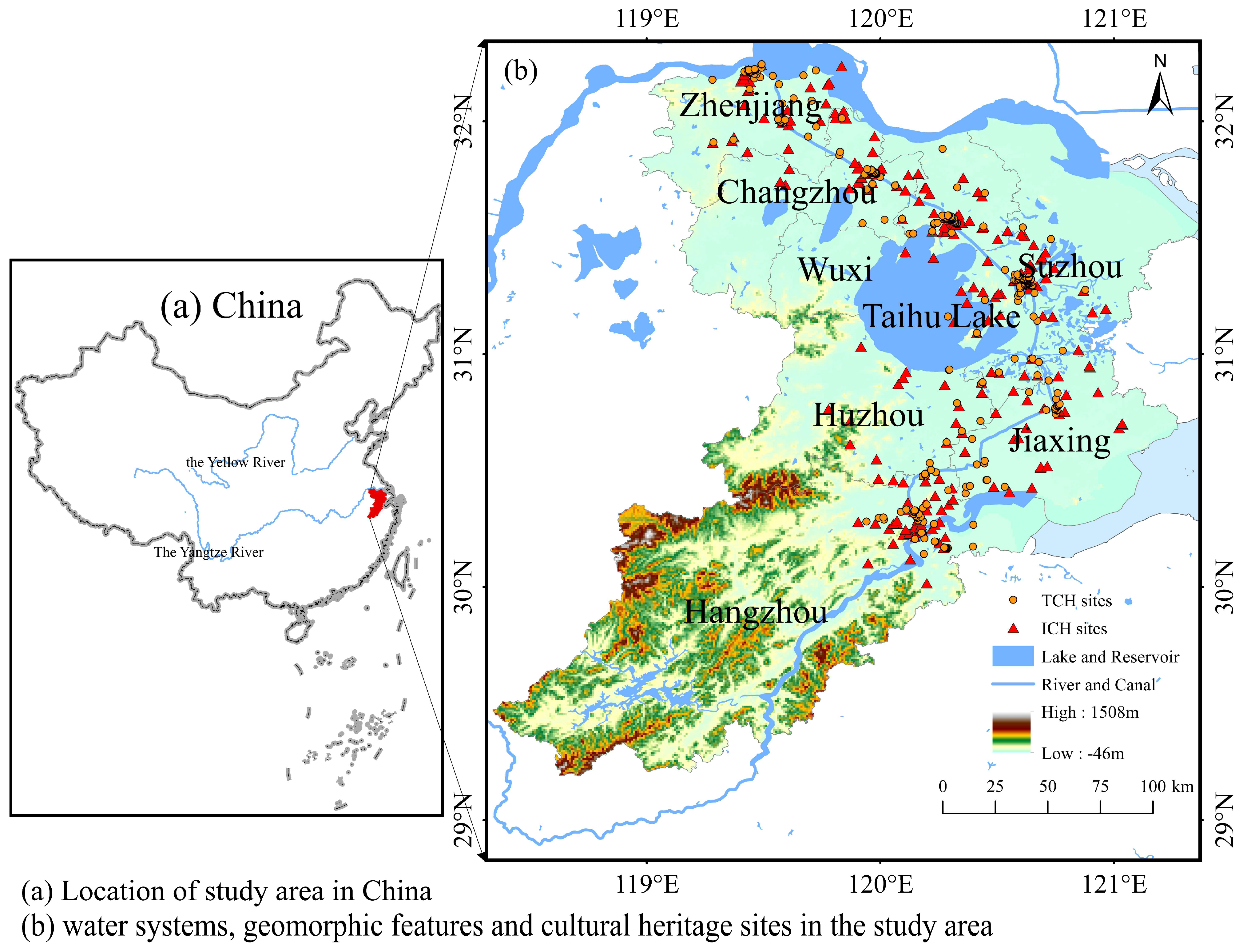

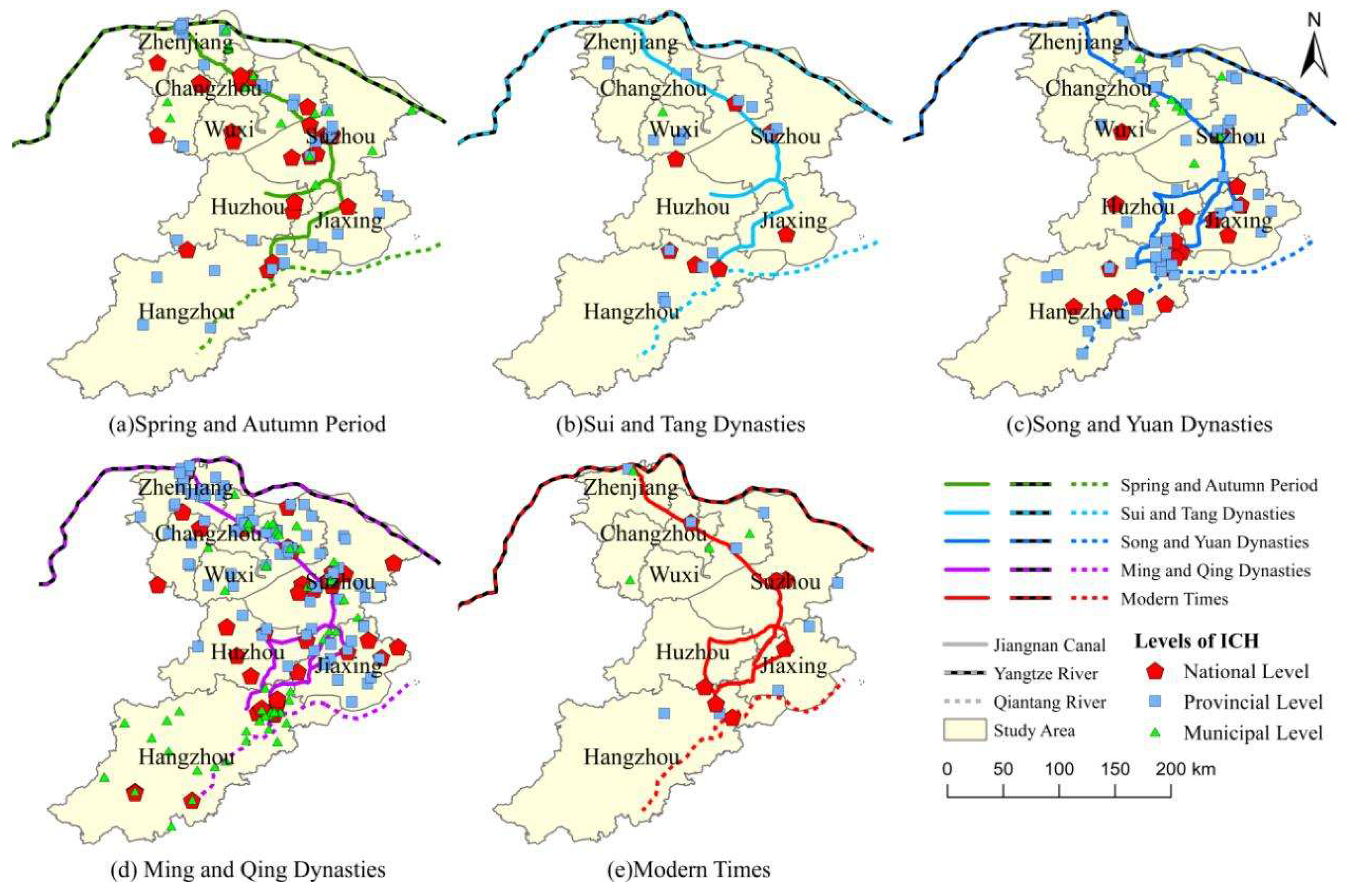
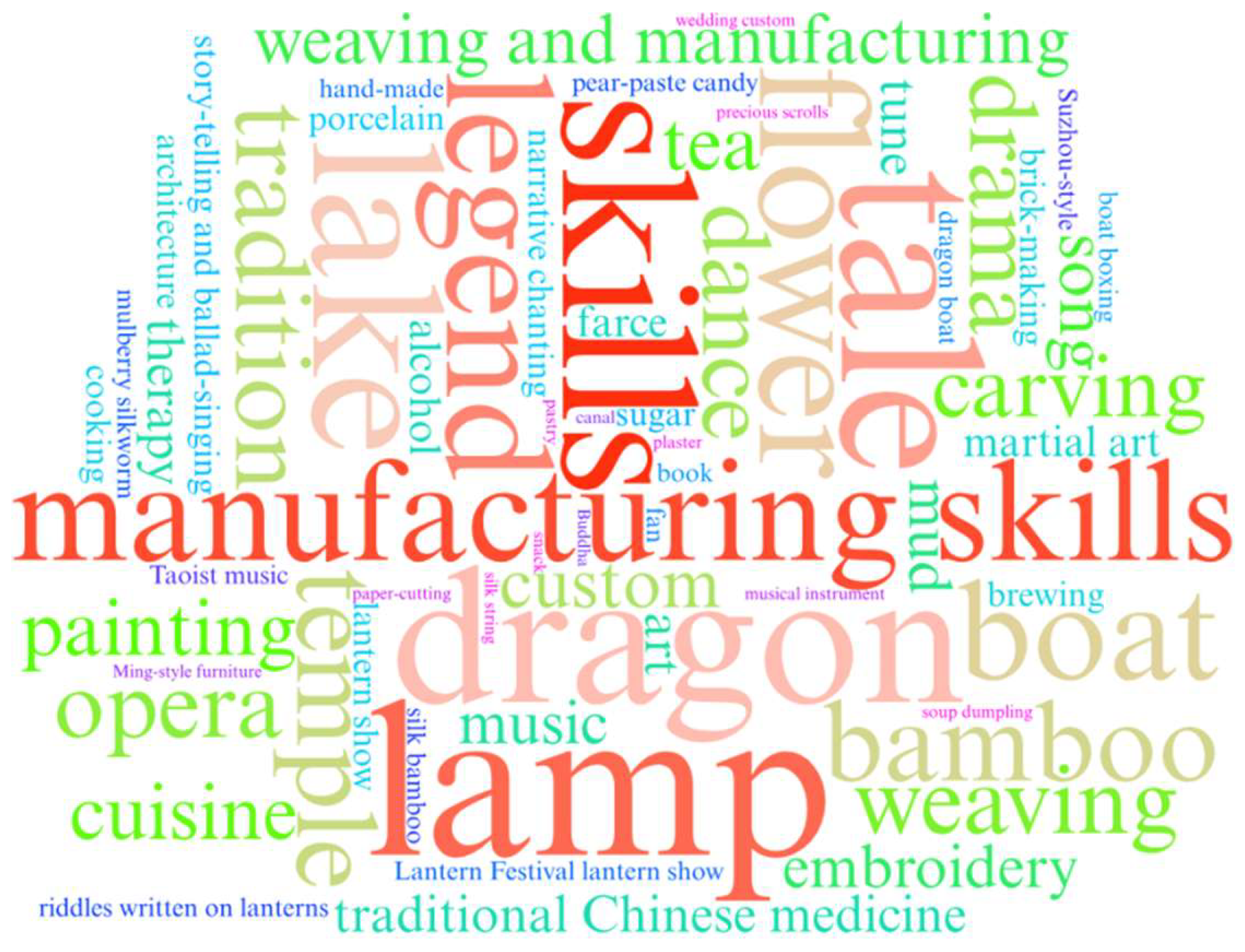
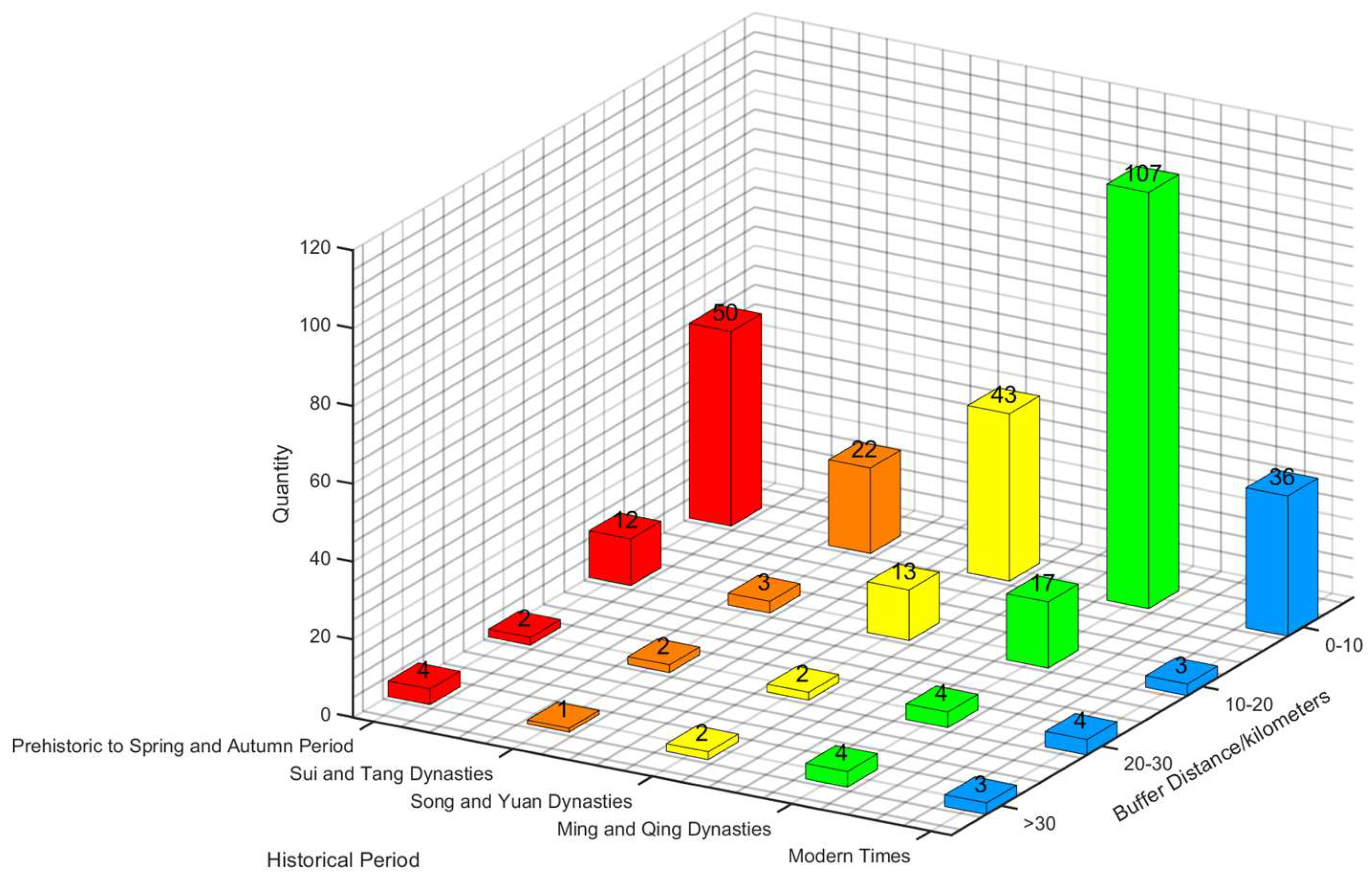
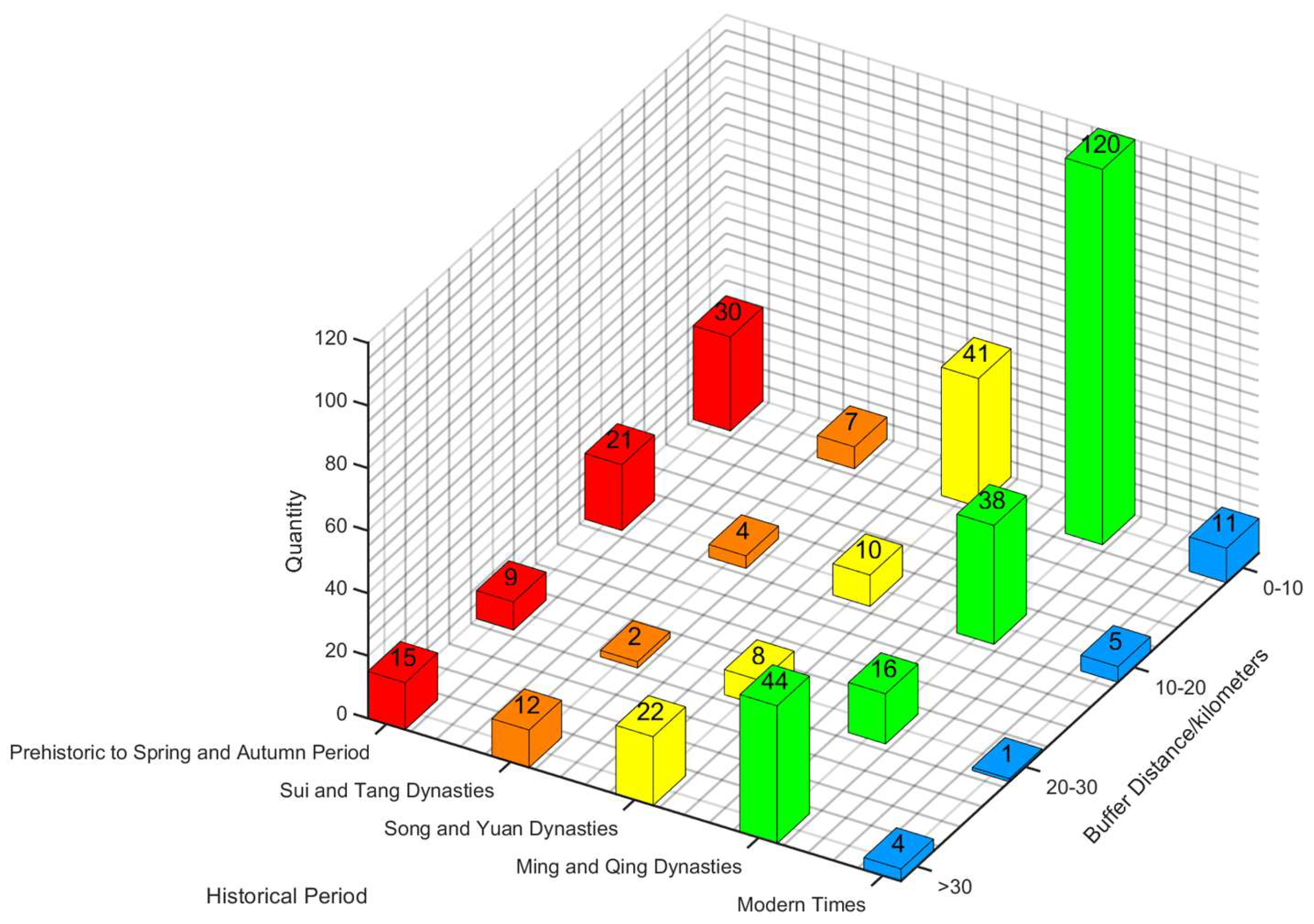
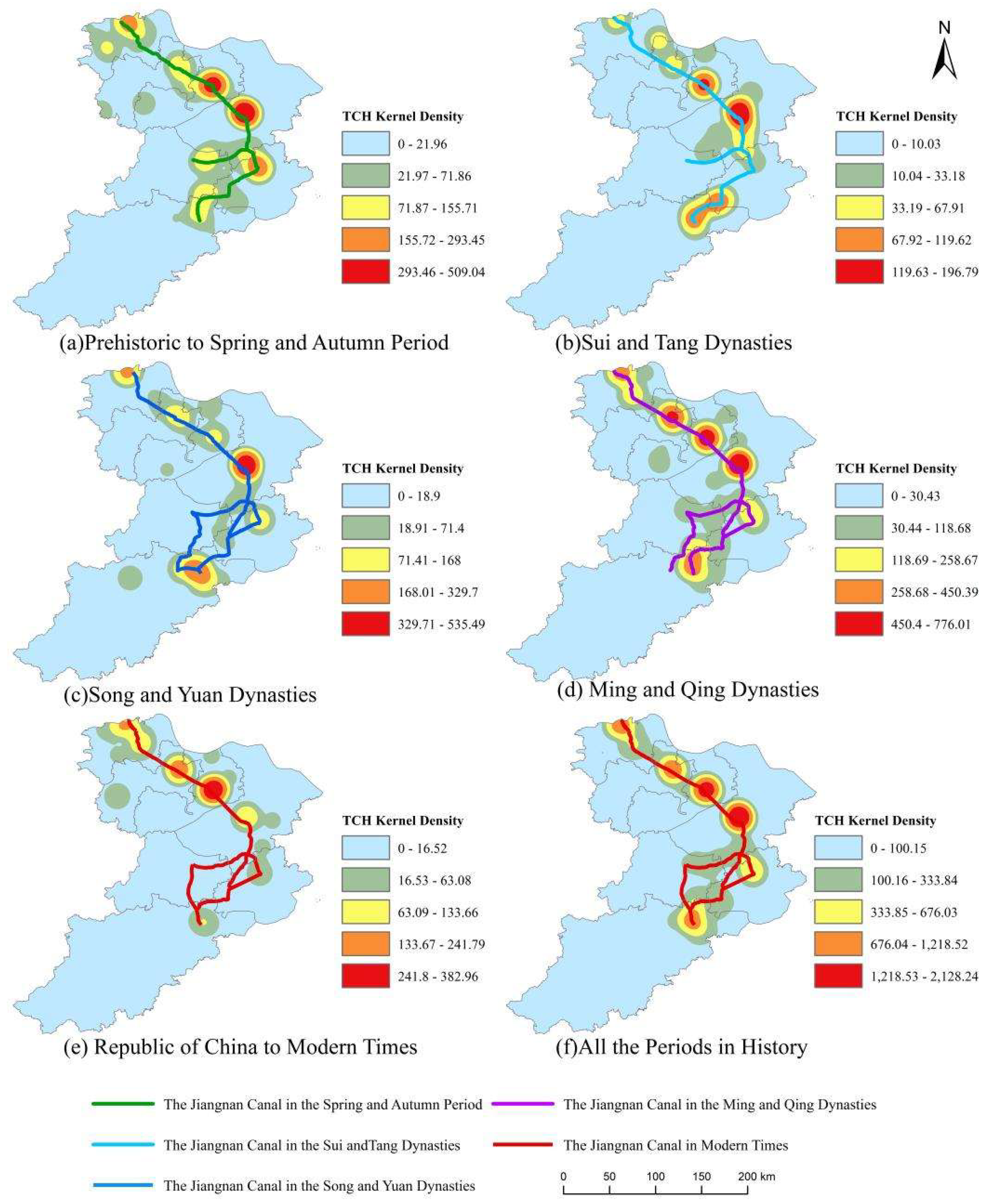
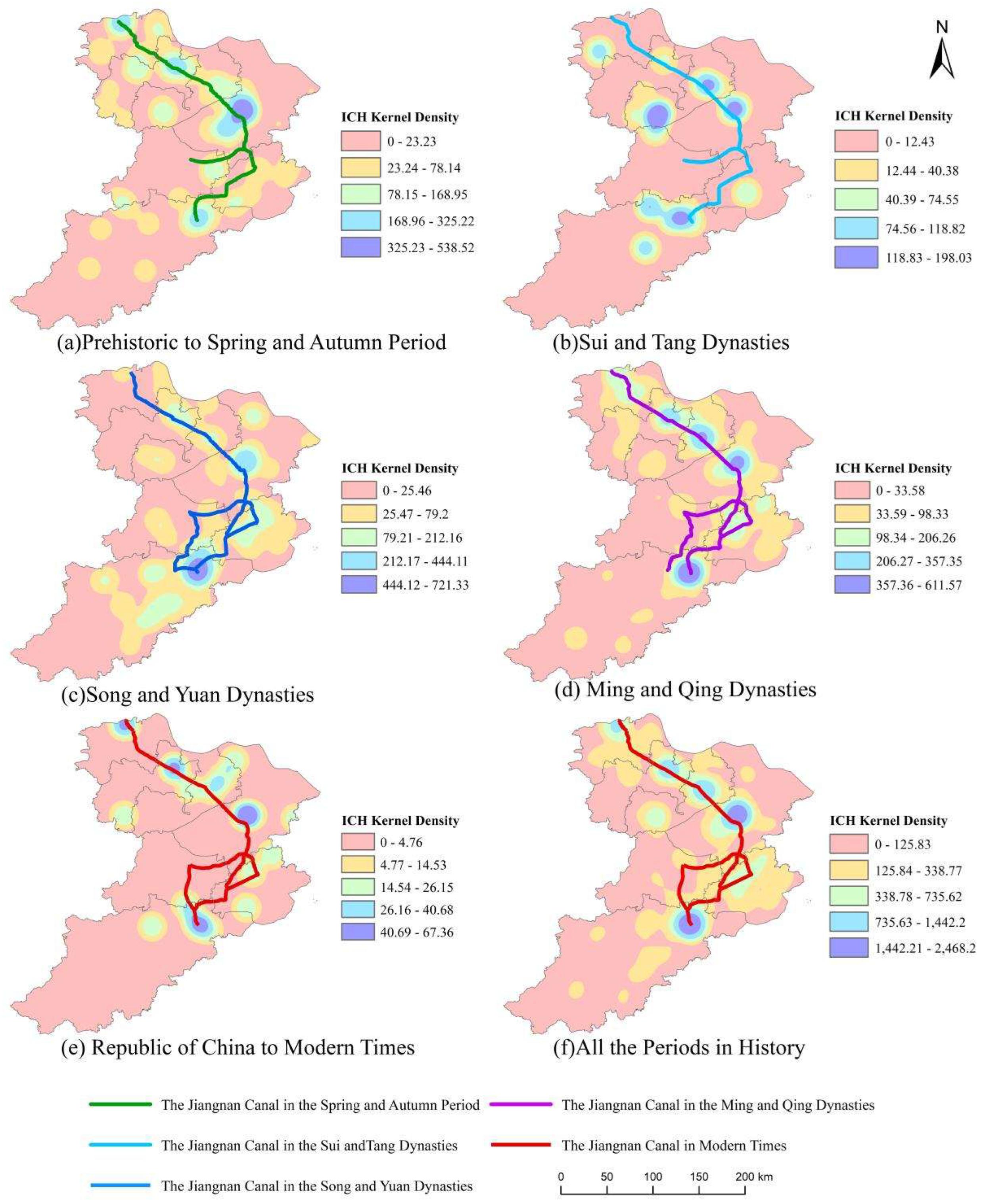
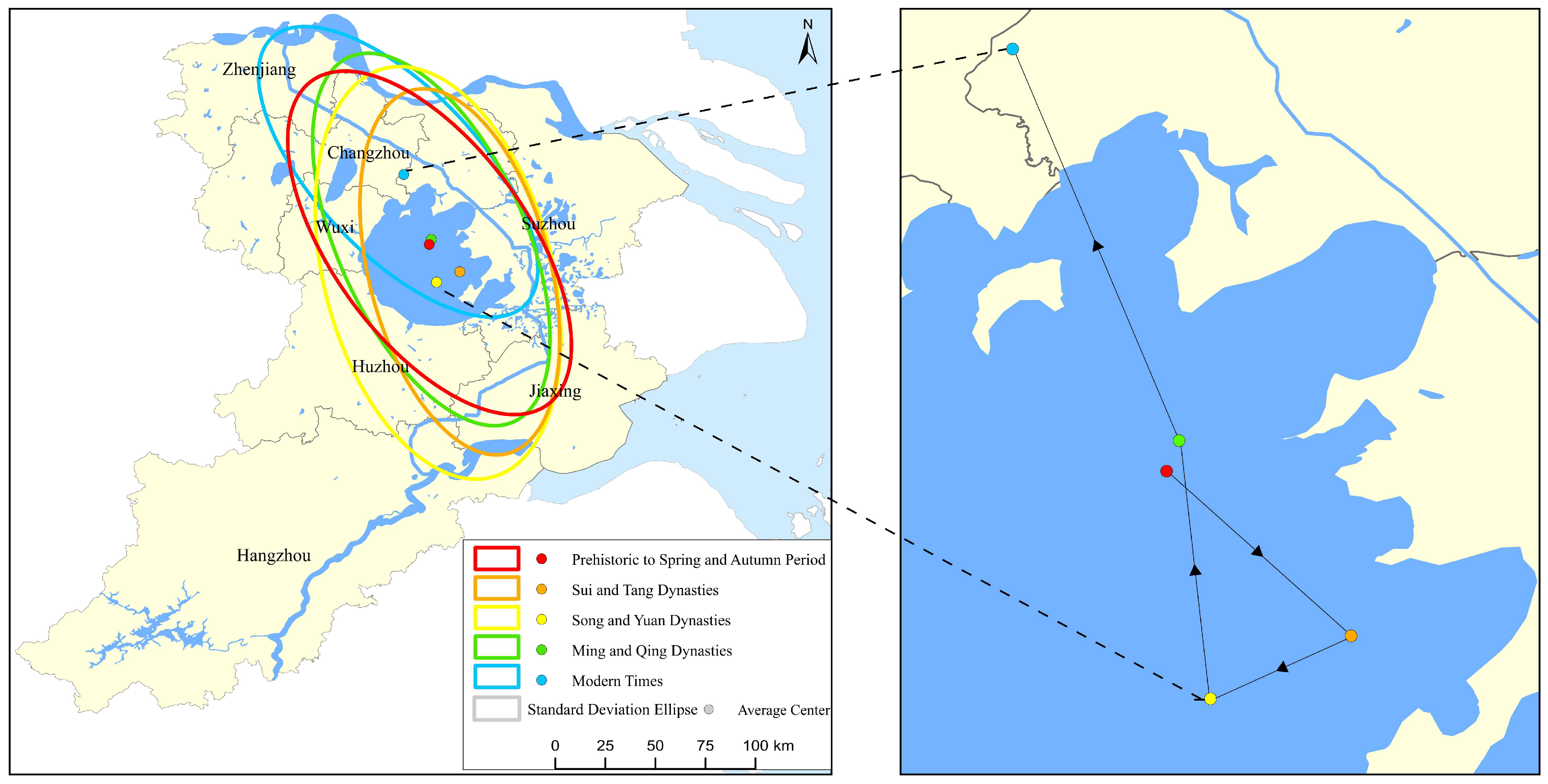
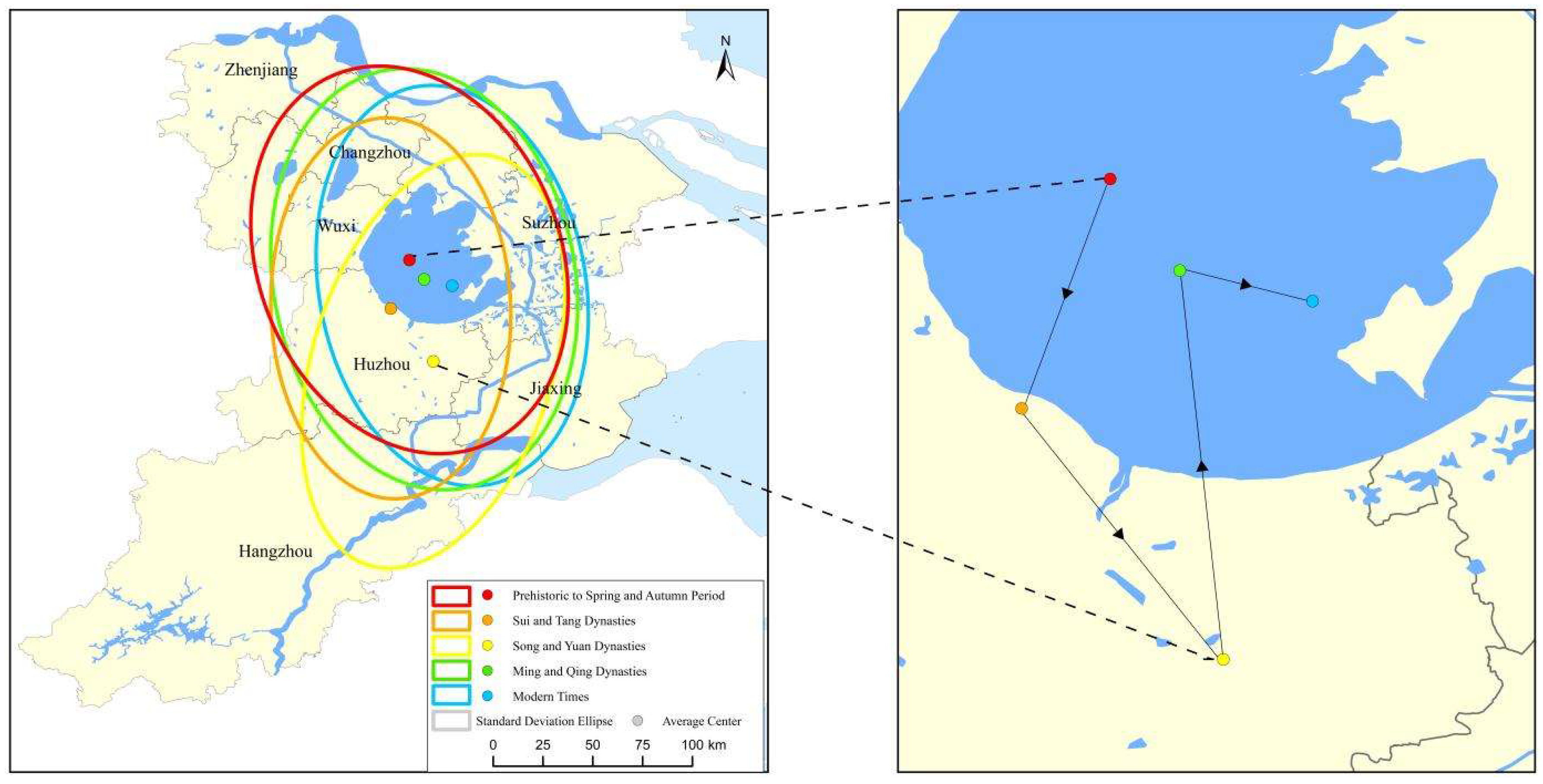
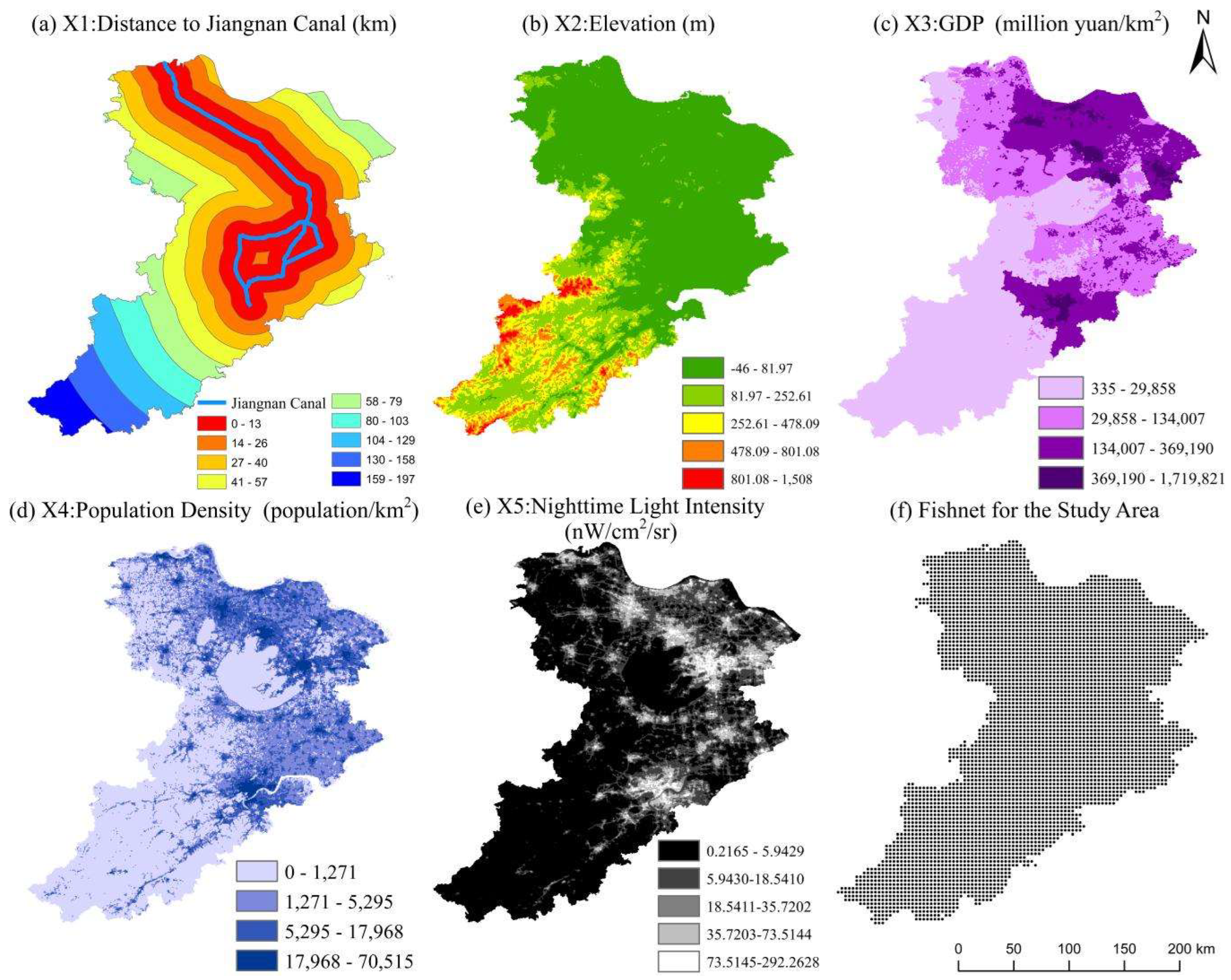
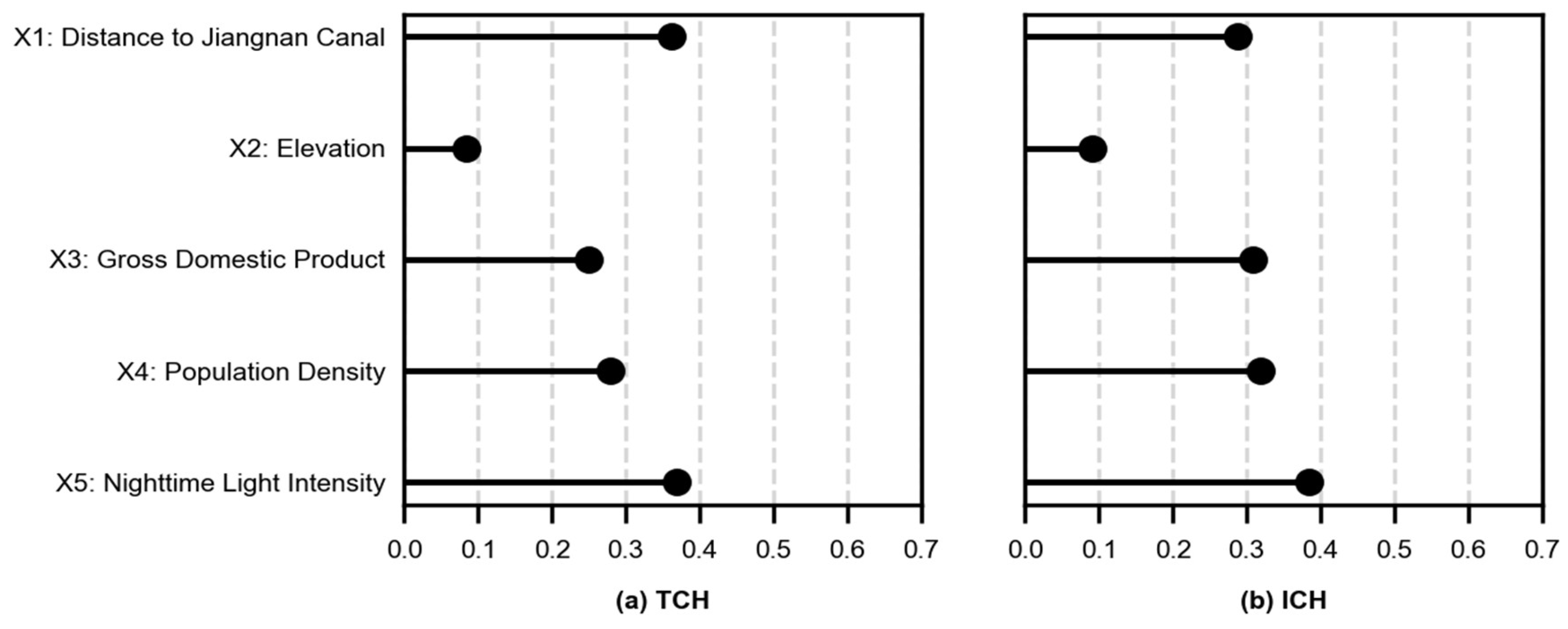
| Content | Source |
|---|---|
| Jiangnan Canal channel data | Historical Atlas of China [33] |
| Yangtze River channel data | Historical Atlas of China [33] https://www.google.com/maps [34] (accessed on 3 December 2024) |
| Qiantang River channel data | Historical Atlas of China [33] https://www.google.com/maps [34] (accessed on 3 December 2024) |
| Tangible cultural heritage data | https://drc.hangzhou.gov.cn/art/2022/2/8/art_1229145709_1840880.html [35] (accessed on 22 September 2024) https://wlt.jiangsu.gov.cn/art/2021/5/25/art_48956_10187654.html [36] (accessed on 22 September 2024) |
| Intangible cultural heritage data | https://www.ihchina.cn/ [37] (accessed on 22 September 2024) https://www.jiangsu.gov.cn/art/2007/3/24/art_46143_2543689.html [38] (accessed on 22 September 2024) https://www.jsfybh.cn/#/homePage [39] (accessed on 22 September 2024) |
| Elevation data | https://www.resdc.cn/data.aspx?DATAID=123 [40] (accessed on 24 February 2025) |
| Water system data | https://www.geodata.cn [41] (accessed on 24 February 2025) |
| Gross Domestic Product data | https://www.resdc.cn/DOI/DOI.aspx?DOIID=33 [42] (accessed on 24 February 2025) |
| Population density data | https://www.resdc.cn/DOI/DOI.aspx?DOIID=32 [43] |
| Nighttime light intensity data | https://landscan.ornl.gov/ [44] |
| Category | Prehistoric to Spring and Autumn Period | Sui and Tang Dynasties | Song and Yuan Dynasties | Ming and Qing Dynasties | Modern Times | Total |
|---|---|---|---|---|---|---|
| Ancient Architecture | 19 | 10 | 35 | 64 | 4 | 132 |
| Important Historical Sites and Representative Buildings | 5 | 6 | 11 | 48 | 41 | 111 |
| Relics of Canal Water Conservancy Projects | 34 | 9 | 3 | 3 | 0 | 49 |
| Ancient Ruins | 9 | 0 | 6 | 7 | 0 | 22 |
| Stone Carvings | 1 | 3 | 5 | 4 | 0 | 13 |
| Ancient Tombs | 0 | 0 | 0 | 6 | 1 | 7 |
| Total | 68 | 28 | 60 | 132 | 46 | 334 |
| Category | Prehistoric to Spring and Autumn Period | Sui and Tang Dynasties | Song and Yuan Dynasties | Ming and Qing Dynasties | Modern Times | Total |
|---|---|---|---|---|---|---|
| Traditional skills | 18 | 14 | 30 | 69 | 7 | 138 |
| Folkways | 13 | 4 | 17 | 20 | 2 | 56 |
| Traditional art | 12 | 1 | 6 | 23 | 3 | 45 |
| Traditional dance | 3 | 1 | 9 | 26 | 0 | 39 |
| Folk literature | 15 | 4 | 5 | 5 | 2 | 31 |
| Dramatic balladry | 1 | 0 | 3 | 24 | 3 | 31 |
| Traditional music | 9 | 3 | 3 | 12 | 1 | 28 |
| Traditional medicine | 0 | 0 | 1 | 19 | 0 | 20 |
| Traditional drama | 0 | 0 | 1 | 14 | 2 | 17 |
| Traditional sports, recreation & acrobatics | 4 | 0 | 4 | 6 | 1 | 15 |
| Total | 75 | 27 | 79 | 218 | 21 | 420 |
| Historical Period | Average Observation Distance/Meters | Expected Average Distance/Metes | Nearest Neighbor Ratio | Z-Score | p-Value | Pattern |
|---|---|---|---|---|---|---|
| Prehistoric to Spring and Autumn Period | 6357.17 | 10,180.84 | 0.6244 | −5.9249 | 0 | Cluster |
| Sui and Tang Dynasties | 10,333.22 | 13,977.62 | 0.7393 | −2.6394 | 0.008306 | Cluster |
| Song and Yuan Dynasties | 5450.06 | 10,963.12 | 0.4971 | −7.4519 | 0 | Cluster |
| Ming and Qing Dynasties | 2589.41 | 6291.74 | 0.4116 | −12.9337 | 0 | Cluster |
| Modern Times | 4508.21 | 11,754.94 | 0.3835 | −7.9989 | 0 | Cluster |
| All the Periods in History | 2078.31 | 5333.71 | 0.3897 | −21.3393 | 0 | Cluster |
| Historical Period | Average Observation Distance/Meters | Expected Average Distance/Metes | Nearest Neighbor Ratio | Z-Score | p-Value | Pattern |
|---|---|---|---|---|---|---|
| Prehistoric to Spring and Autumn Period | 9693.43 | 13,388.96 | 0.7240 | −4.5729 | 0.000005 | Cluster |
| Sui and Tang Dynasties | 9895.94 | 15,925.74 | 0.6214 | −3.6216 | 0.000293 | Cluster |
| Song and Yuan Dynasties | 10,039.32 | 13,001.38 | 0.7722 | −3.9226 | 0.000088 | Cluster |
| Ming and Qing Dynasties | 4931.89 | 8812.93 | 0.5596 | −12.4390 | 0 | Cluster |
| Modern Times | 18,083.94 | 20,614.27 | 0.8773 | −1.0761 | 0.281885 | Cluster |
| All the Periods in History | 3203.86 | 6416.60 | 0.4993 | −19.6303 | 0 | Cluster |
Disclaimer/Publisher’s Note: The statements, opinions and data contained in all publications are solely those of the individual author(s) and contributor(s) and not of MDPI and/or the editor(s). MDPI and/or the editor(s) disclaim responsibility for any injury to people or property resulting from any ideas, methods, instructions or products referred to in the content. |
© 2025 by the authors. Licensee MDPI, Basel, Switzerland. This article is an open access article distributed under the terms and conditions of the Creative Commons Attribution (CC BY) license (https://creativecommons.org/licenses/by/4.0/).
Share and Cite
Liu, R.; Meng, D.; Wang, M.; Gong, H.; Li, X. Analysis of Spatiotemporal Dynamics and Driving Mechanisms of Cultural Heritage Distribution Along the Jiangnan Canal, China. Sustainability 2025, 17, 5026. https://doi.org/10.3390/su17115026
Liu R, Meng D, Wang M, Gong H, Li X. Analysis of Spatiotemporal Dynamics and Driving Mechanisms of Cultural Heritage Distribution Along the Jiangnan Canal, China. Sustainability. 2025; 17(11):5026. https://doi.org/10.3390/su17115026
Chicago/Turabian StyleLiu, Runmo, Dan Meng, Ming Wang, Huili Gong, and Xiaojuan Li. 2025. "Analysis of Spatiotemporal Dynamics and Driving Mechanisms of Cultural Heritage Distribution Along the Jiangnan Canal, China" Sustainability 17, no. 11: 5026. https://doi.org/10.3390/su17115026
APA StyleLiu, R., Meng, D., Wang, M., Gong, H., & Li, X. (2025). Analysis of Spatiotemporal Dynamics and Driving Mechanisms of Cultural Heritage Distribution Along the Jiangnan Canal, China. Sustainability, 17(11), 5026. https://doi.org/10.3390/su17115026







